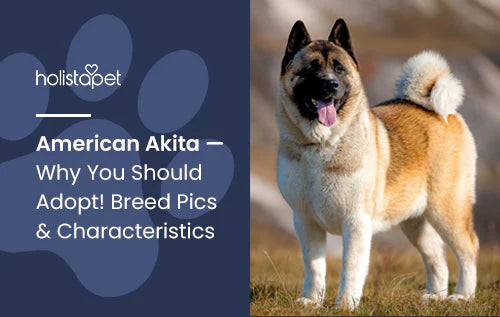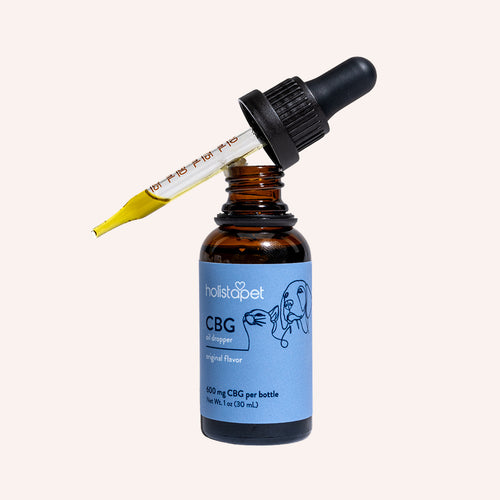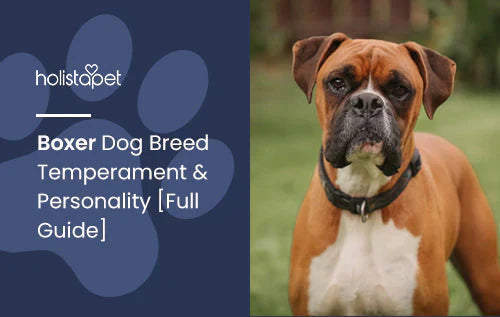The American Akita is a unique dog breed that resembles a bear. They have an aloof and willful personality that makes for an excellent watchdog and powerful guard dog. Akitas have been guarding since the 1600s, but American Akitas, in particular, have become the largest of these brave spirits. They were originally referred to as "snow country dogs" before becoming an official breed.
American Akita : Breed Traits & Characteristics
This heavy-boned breed is popular for being much larger than the other well-known Akita breed, the Akita Inu. The American Akita is a powerful Spitz breed with a massive build and a sturdy stance. Their skin is pliant (but not loose), and they have solid muscular bodies covered with a double coat that's short and lush.
Check Out : CBD For Dogs
An Akita's underlying hair is dense and fine, while their overlying hair is straight, coarse, and harsh. Their hair becomes slightly longer towards the lower end of their neck, stomach, and hindquarters. They have some long hair, but it's only found on their tail. This dog has a slightly tapered muzzle with a black nose, strong deep jawline, and thin black lips. Their necks are thick, medium-length, and muscular.

In the past, this great Japanese dog would use its dewclaws as ice picks to help them commute in frozen terrains. Their cat-like feet have hard pads, plenty of fur, and are knuckled up. Their toes are also webbed, which helps them walk on the snow by distributing their weight evenly. Though Akitas are perfectly built for work with their size and physical characteristics, they also make great indoor dogs. They love to cuddle and are fiercely protective of their families and their territory.
American Akita Size
Akita American dog are one of the biggest registered dog breeds, and there is quite a size difference between males and females. Fully-grown female Akita weighs about 70 to 100 pounds and stand at 24 to 26 inches at the withers. Males range from 100 to 130 pounds and usually reach heights between 26 and 28 inches tall.
Because of their size, the full grown American Akita is often confused with another similar dog — the Japanese Akita Inu. Many believe the only difference is size, but there are many more differences to notice that they are not the same dog breed.
American Akita Personality
The Akita may look like a typical outdoor dog, but they are perfectly happy living in houses with their families. American Akitas are known for their courageous, dignified, and profoundly loyal personalities. They are very devoted to their owners, and because of this, they make excellent watchdogs.
Part of this has to do with the fact that Akitas are quite territorial, protective, and fearless. They're also widely known for being suspicious of strangers. Luckily, they're not a very talkative dog breed! Because of this, when they warn you of strangers or a sudden change in surroundings, you'll know their alert is worth checking on. When they become vocal, their bark somewhat resembles a murmur or moan.

Aside from a readiness to bark at intruders, the Akita dog won't hesitate to confront — and even bite — especially if they feel threatened. This is why some countries consider them to be a dangerous breed. Fortunately, Akitas can be trained to be more well-disciplined around strangers with the proper training.
Dealing With an American Akita's Personality
Since Akitas are less tolerant of strangers, it may be wise to be present when your dog meets guests. For this reason, many owners post dog "warning signs" on their fences or gates. Additionally, their excess energy can manifest into them becoming antsy dogs if not properly expelled. An Akita with too much unused energy may take it out on their environment.
This is typical of their behavior, as they're known for being sensitive to how you treat them. How they're treated will always reflect in their behavior. If you adopt an American Akita, keeping them as your only pet might be best. Akitas are often possessive and jealous dogs. Without proper training, they're often selfish with their food bowl and toys—and may even be with you! Understandably, this personality type can sometimes lead to trouble with other pets.

Puppy Personality
Akita puppies are courageous, intelligent, and loving. Though they are more hesitant toward strangers, they love their families and will be happy to spend time with you wherever you go! They also love to cuddle, so if you're a fan of snuggling up with pups, the American Akita puppy is probably for you.
The Importance of Early Socialization
Since American Akita dogs are more territorial, you must socialize your Akita puppy from a very young age. By introducing them to other animals (like cats and other dog breeds), children, and both friends and strangers, you'll be able to help your pup grow into a more socialized dog.
Puppy age is the perfect age to begin this socialization process. You can begin by introducing your puppy to your friends and other dogs one at a time in controlled environments. They may act out when meeting many dogs at once. When your dog is more comfortable around friends, you can begin training them to be more accepting of strangers. Daily walks are a great time to do this!
American Akita Exercise
Akitas are not a very active breed, but daily exercise is still recommended so they don't become overweight or bored. They do well with long walks in cool weather, hikes, and playtime in the yard. Ensure there is plenty of space wherever you plan to have your playtime because Akitas needs lots of room to run. Since they are larger and heavier dogs, you may want to be wary of their surroundings before playtime — they may knock things over while playing.
We suggest you have your Akita play a game or learn tasks that require them to carry something in their mouth. They enjoy these games as they stimulate their minds and appeal to their innate hunting nature. Because they are classified as working dogs, Akitas are accustomed to exercising while on the job. They are excellent working dogs and are primarily utilized for watching and guarding.

Akita Training
As you'd imagine, independent breeds like the Akita are tough to train. Some people enjoy this aspect of the breed and consider it a fun challenge. Akitas are notorious for becoming problematic when not appropriately trained. These dogs require a strict, disciplinarian owner because they are intelligent and stubborn.
This is what makes them so tricky to train, but with the right training, they excel and even compete in dog sports. For this reason, new dog owners may want to think twice before adopting this breed. Obedience classes may also be beneficial for newer owners or those who want extra training help.
How Can I Make Training Easier?
Fortunately, we have some tips for training your Akita successfully! We highly recommend starting by training your Akita puppy at an early age. This includes socialization to get them used to seeing other people and pets, as they're naturally more antisocial animals.
Early and Easy Housebreaking
Since they would much rather be inside with you, the Akita usually potty trains fairly quickly. You can start potty training by encouraging them to go potty outside with treats or soft chews.

Incorporate A Dog Training Collar
Akita training guides strongly suggest the strategic use of a dog training collar. These collars can help this breed learn quickly and produce a well-behaved, obedient dog. You will also rest easy knowing you've trained them well for the sake of others' safety.
Practice Patience and Persistence
Above all, this breed needs to be trained with love and respect. Patience and persistence are essential for obedience training. If you react negatively during training or treat them harshly, they may lash out in return. Positive reinforcement goes a long way with Akitas.
Allow Them to Lead
Another useful thing to know about the Akita is that you should let them guide you if they want to lead you somewhere. They likely want to show you something, especially if you aren't paying them proper attention. Remember, any use of force or bullying is unacceptable and will set you up to own an aggressive adult Akita dog!
Are They Aggressive?
The American Akita is a bold, alert, and headstrong dog. Though they're wary of strangers, this loyal breed loves its family and those close to them. Because of this, they tend to be more aggressive towards other dogs, especially those of the same sex. Unless you adopt puppies together and socialize them with one another as they grow up, it's usually recommended that Akitas live in single-dog households.
Can They Be Friendly?
Akitas usually only tolerate other animals — again, they're likely to be friendlier if you socialize them well from a young age. Since they were originally bred to be hunting dogs, Akitas work hard to maintain status as "top dog" in their household. Generally, though, Akitas are friendly and affectionate toward their family and friends.

Related: Dog Aggression – How To Calm with Cannabidiol
American Akita History
The Akita is part of the Spitz breed family. Other breeds that likely played a role in their development include the English Mastiff, Great Dane, Tosa Inu, and St. Bernard. They have a long and interesting past due to breeding, controversial use, and their introduction to North America.
Read More : Probiotics For Dogs
Akita Inu
The Japanese Akita Inu was the first and most similar breed to the American Akita. They are from Japan and were used during World War II. During this time, there was also a lot of controversy due to their use in brutal fighting. People also killed them for their beautiful coats. You can characterize Akita Inus by their fox-like faces and standing ears. Their claim to fame also includes guarding Japanese royalty in the 1600s. Many believe this regality is echoed in the personalities of their descendants.

American Akita
The history of the American Akita began with the famous author, lecturer, and humanitarian, Helen Keller. She first introduced the Akita to the United States in 1937, when she imported hers from Japan. While touring Japan in 1937, she visited the Akita Prefecture, where she heard of Hachiko, the famed Akita dog. Impressed with the story, she expressed that she wanted an Akita dog of her own.
Mr. Ogasawara, a member of the Akita Area Police Department, gave her a two-month-old Akita puppy named Kamikaze-go as a gift. Kamikaze-go sadly passed away of canine distemper not long after coming to the United States. After this occurred, his brother, Kenzan-go, was sent to Ms. Keller as an official present from the Japanese government in July 1938.
The famous Keller wrote this in her Akita Journal about Kamikaze-go:
"If ever there was an angel in fur, it was Kamikaze. I know I shall never feel quite the same tenderness for any other pet. The Akita dog has all the qualities that appeal to me — he is gentle, companionable, and trusty."

Akita Health Problems
The American Akita life expectancy is approximately 12 to 15 years. This is a relatively long life, especially for larger dogs. Even though the Akita is a healthy breed, they have a small gene pool in the United States. This means they're more prone to various genetic and other diseases, including the following:
Eye Problems
Akitas' eyes might encounter progressive deterioration of cells over time. In such cases, this slowly destroys the photoreceptor cells in the eyes. Eventually, it can lead to blindness in affected dogs.
Hip Issues
This is a relatively common skeletal condition, and we often see it happen with larger dogs. Hip deformities can often occur during growth, and they affect mobility. They are usually inherited and can cause painful wear and tear later in life.
Gland Issues
The glands located in dogs' necks make a hormone called thyroxine, which controls their metabolism. When the gland doesn't make enough of that hormone, it can often affect larger dogs. Symptoms include hair loss, flaky skin, and sluggishness, among other things. If caught on time, this condition is inexpensive and treatable. If left untreated, it can become problematic.
Renal Issues
Akitas are prone to this condition. It is a genetic form of kidney problem that can start when Akitas are puppies. Early signs may include excessive water drinking, urinating, poor appetite, and weight loss. Once this condition progresses, it may cause loose stool or throwing up.
Bloat
Gastric Dilatation-Volvulus is a rapidly progressive life-threatening condition for the Akita. Bloating is when a dog's stomach fills with fluid, gas, or food and expands. This expansion puts pressure on other organs. Once this happens, the blood becomes trapped in the stomach, preventing it from returning to the heart and other areas. This may send your dog into shock, giving you only a few minutes to get them to a vet.
It's often suggested that owners watch a video of bloat occurring so they can know when and how to jump into action immediately.
How to Care For an Akita

The Akita requires a lot of attention and mental stimulation in every way, but they'll undoubtedly reward your efforts. They are generally very clean dogs who enjoy taking care of themselves. Talk to your vet about what to keep an eye out for when it comes to good health, and be sure to take them in for their check-ups regularly.
Caring for an Akita also means spending a lot of time with them — Akita parents must be patient, loving, and firm. These dogs will follow you from room to room or cuddle up next to you with a good movie because they love being with their human family. Even after socializing and training, it is best to stay close to your Akita dog when around strangers or other pets. They can be unpredictable when bothered.
Nutrition and Feeding for Akitas
This dog breed requires a proper diet of high-quality dry foods mixed with fresh foods. Their protein needs are essential to maintain their robust physical structure. The best amount to go off is 1 gram of protein per pound of the american akita weight. Similar to other high-energy breeds, how much you feed your Akita will vary depending on their physical activity level. Ask for regular weigh-ins at the vet to determine whether you need to give your pup more or less food.
Puppy Nutrition & Feeding
Since Akita puppies grow up to be large dogs, you'll likely need to adjust your puppy's feeding regime monthly to match their growth. We recommend starting your puppy with a smaller amount, split into more feedings throughout the day. By feeding your pup up to four times a day, you can support their metabolism, energy levels, and development!

Here are some feeding suggestions for your growing puppy:
- Up to 200 grams per day for puppies up to 3 months
- 250 grams per day for puppies aged 4-5 months
- Up to 400 grams per day for 6-month-old puppies
- Up to 300 grams per day for puppies aged 7-8 months
As your puppy ages, you can lower the number of times you feed them from 3-4 to twice daily. We advise you to continue feeding your pet puppy food until they're at least one year old, though, so they can continue to reap the benefits of added nutrients in puppy chow. Regarding choosing food for your Akita puppy, we suggest looking for organic brands that offer lines specifically for puppies. Puppy food is much higher in calories and will better support your pup's growth. It also provides a wider range of vitamins and supports bone health.
Coat Color and Grooming
Akita coat can come in numerous colors. There are 9 colors and 5 markings registered by the American Kennel Club: black, pinto, brindle, white, fawn, and red. These colors can vary in shades, combinations, and markings. Regardless of each dog's coat appearance, their color will be rich, brilliant, and clear.
Unlike the Japanese Akita, the American Akita often has a black mask. This black mask is likely exactly what you imagine — a face covered with black overlay fur that goes around the eyes and mouth. There will also be well-balanced markings, with or without a mask or blaze. Pinto-colored Akitas have a white background, with large patches covering their heads and more than one-third of their bodies.

For such a big, fluffy dog, Akitas are easy to groom. This dog is similar to cats in that they like to groom and maintain their appearance. You'll find yourself grooming your house more than your dog because this breed sheds a lot. We suggest you groom your Akita a few times per week to help manage shedding and support proper oil distribution in their fur. You should also bathe them a few times per month and trim their toenails once a month.
Are They Hypoallergenic?
American Akitas are not hypoallergenic. They have a lot of hair and fluff and are very likely to cause a reaction to anyone who is allergic to dogs.
Children and Other Pets
When socialized, the Akita can quickly get along with dogs of the opposite sex, but they often have trouble with dogs of the same sex. They should also be kept away from small pets like cats since they are driven to chase and hunt prey.If properly trained, these dogs may adapt to share their home with others, but it's not recommended.
If you would like a second Akita, the best choice would be to get two opposite-sex Akitas. Since Akitas are large, hefty dogs, they can accidentally injure small children. As a precaution, children should be old enough to treat this dog breed properly and always be monitored when they interact with it. CBD oil for dogs may help calm this breed around children and pets.
Rescue Groups
If you are ready to commit, we recommend that you check out a few rescue group options. Any of these organizations can help you bring home your next best friend:
- Namaste American Akita — located in California.
- Big East Akita Rescue — located in New York, New Jersey, and Pennsylvania.
- TikiHut Akita Rescue Association — located in Northern California.
- Midwest Akita Rescue Society — Serves Illinois, Indiana, Iowa, Michigan, Minnesota, Missouri, Ohio, Wisconsin, and parts of Kansas and Kentucky.
- Rakki-Inu Akita Rescue — Serves North and South Carolina and Virginia.
Breed Organizations
Many organizations discussed this dog breed together before it received its classification. Eventually, the Japanese Kennel Club classified the American Akita. The JKC is also responsible for submitting the formal proposal to FCI for a breed split between the Japanese and American Akita dog breeds.
Check out these breed organizations, including the Akita Club of America — the only National Akita Breed Club — to learn more about the history of the Akita breeds:
Cost and Maintenance
Owning an Akita comes with both initial and ongoing expenses. The cost of acquiring a purebred Akita can range from $1,000 to $2,500, depending on if it's from a reputable breeder and lineage. Beyond the purchase price, maintenance costs include high-quality food, regular grooming, veterinary care, and training. Due to their thick double coat types, American Akitas require regular brushing and occasional professional grooming.
Final Thoughts - American Akita
Today, the American Akita is the 47th most popular purebred breed in the United States of America. This dog breed has had a long history to get where it is today but will certainly make a great friend and companion.
Learn more about how to care for your Akita with us at HolistaPet!


 CBD Oil for Dogs - Fast Acting
CBD Oil for Dogs - Fast Acting
 Chicken Flavored CBD Oil For Dogs - Easy Dose
Chicken Flavored CBD Oil For Dogs - Easy Dose
 Salmon Flavored CBD Oil For Dogs - Highly Rated
Salmon Flavored CBD Oil For Dogs - Highly Rated
 CBG Oil for Dogs and Cats - Loved by Thousands
CBG Oil for Dogs and Cats - Loved by Thousands





Leave a comment
All comments are moderated before being published.
This site is protected by hCaptcha and the hCaptcha Privacy Policy and Terms of Service apply.